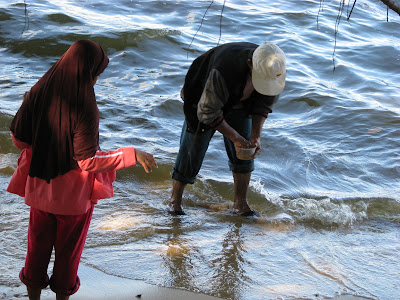
For the second time in a row, I did not take any pictures during Semakau guiding. Only took this on the left. Hopefully can recieve some photos from my participants soon :) But in the meanwhile, let me just share abit about this amazing creature here and prehaps clear some misconceptions.
Periclimenes brevicarpalis is commonly known as the glass shrimp, anemone shrimp or the cleaner shrimp. This strikingly beautiful animal has a symbiotic relationship with sea anemones and is known to inhabitat on 14 such species. The ability of anemone shrimps to reside on the anemone without being stung is not due to its exoskeleton, but rather by acclimating themselves coating itself with the mucus secretions of the anemone just like our anemone fish.
The partially transparent body of this shrimp enables it to break out its body outlines; an adaptation known as distruptive coloration, so that it is not easily visible to predators. It also gain protection from its anemone host.

It is hard to define the exact symbiotic relationship of this shrimp towards its host, although it is commonly describe as being commensal. It is known that
P. brevicarpalis clip off and feeds on its hosts' tentacles, the Bubble anemone (
Entacmaea quadricolor) for food and thus had even also been described as parasitic. However, it is also possible that it have beneficial behavior to its host, of helping to clean the anemone of ectoparasites and/or supplying nitrogenous waste products to its host as seen in other shrimps of the same genus.
Hope this facts are not too much to digest! Now to lighten things a little.... Do u know the chinese name for anemone is 有没有钱?Just translate it to English and u will know. hahaa
Semakau intertidal walk, 8th March 2008

 For people who have a passion for fishing, please do not throw away unwanted lines and hooks anywhere. This may pose a potential danger to birds which can get entangled or cut by them. See the sad story of the heron killed by such in BESG blog.
For people who have a passion for fishing, please do not throw away unwanted lines and hooks anywhere. This may pose a potential danger to birds which can get entangled or cut by them. See the sad story of the heron killed by such in BESG blog. 

 To me, cockatoos are remarkable acrobats for their size, hanging at seemingly impossible angles to reach their food. Their beaks also seemed to act as a third limb, just like how some monkeys use their prehensile tails.
To me, cockatoos are remarkable acrobats for their size, hanging at seemingly impossible angles to reach their food. Their beaks also seemed to act as a third limb, just like how some monkeys use their prehensile tails.